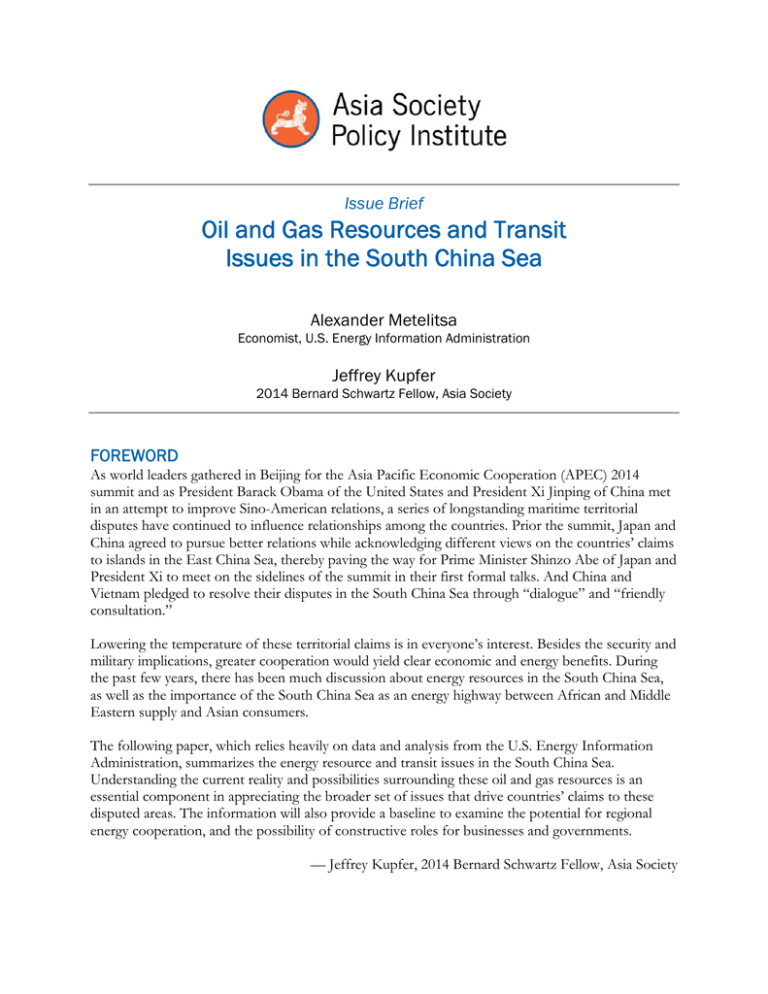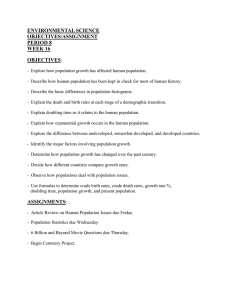Oil and Gas Resources and Transit Issues in the
advertisement

Issue Brief Oil and Gas Resources and Transit Issues in the South China Sea Alexander Metelitsa Economist, U.S. Energy Information Administration Jeffrey Kupfer 2014 Bernard Schwartz Fellow, Asia Society FOREWORD As world leaders gathered in Beijing for the Asia Pacific Economic Cooperation (APEC) 2014 summit and as President Barack Obama of the United States and President Xi Jinping of China met in an attempt to improve Sino-American relations, a series of longstanding maritime territorial disputes have continued to influence relationships among the countries. Prior the summit, Japan and China agreed to pursue better relations while acknowledging different views on the countries’ claims to islands in the East China Sea, thereby paving the way for Prime Minister Shinzo Abe of Japan and President Xi to meet on the sidelines of the summit in their first formal talks. And China and Vietnam pledged to resolve their disputes in the South China Sea through “dialogue” and “friendly consultation.” Lowering the temperature of these territorial claims is in everyone’s interest. Besides the security and military implications, greater cooperation would yield clear economic and energy benefits. During the past few years, there has been much discussion about energy resources in the South China Sea, as well as the importance of the South China Sea as an energy highway between African and Middle Eastern supply and Asian consumers. The following paper, which relies heavily on data and analysis from the U.S. Energy Information Administration, summarizes the energy resource and transit issues in the South China Sea. Understanding the current reality and possibilities surrounding these oil and gas resources is an essential component in appreciating the broader set of issues that drive countries’ claims to these disputed areas. The information will also provide a baseline to examine the potential for regional energy cooperation, and the possibility of constructive roles for businesses and governments. — Jeffrey Kupfer, 2014 Bernard Schwartz Fellow, Asia Society 2 | Oil and Gas Resources and Transit Issues in the South China Sea RISING ENERGY DEMAND IN ASIA Asia’s robust economic growth makes it the center of growth in worldwide energy demand during the next few decades. According to the U.S. Energy Information Administration’s (EIA) International Energy Outlook 2014, China, India, and other developing countries in Asia are projected to account for 72% of the net world increase in consumption of petroleum and other liquids to 2040. 1 Similarly, EIA projects that these same developing Asian countries will increase their natural gas consumption by 3.9 percent annually, from 10 percent of world gas consumption in 2008 to 19 percent by 2035.2 EIA expects China to account for 43 percent of that growth as the government seeks to reduce air pollution and carbon dioxide emissions by replacing some of the country’s coal and oil use with natural gas. The Chinese government anticipates increasing its natural gas share of total energy consumption from the current level of about 5% to around 8% by the end of 2015 and 10% by 2020.3 OIL AND NATURAL GAS RESOURCES In light of this rising Asian energy demand, the coastal countries of the South China Sea have been interested in developing their potential offshore reserves. At the same time, many countries have overlapping territorial claims to portions of the South China Sea, which stretches from Singapore in the southwest to Taiwan in the northeast. The Spratly Islands and Paracel Islands are two of the most disputed areas (see dark blue islands on Figure 1 below). Figure 1: South China Sea oil and natural gas proved and probable reserves4 3 | Oil and Gas Resources and Transit Issues in the South China Sea Figure 2: Share of world proved oil and gas reserves for select regions (2012)5 In total, EIA estimates that the South China Sea contains about 11 billion barrels of oil and 190 trillion cubic feet of natural gas rated as proved or probable reserves. These levels are similar to the amount of proved oil reserves in Mexico and are about two-thirds of the proved natural gas reserves in Europe, not including Russia (Figure 2).6 For context, China consumed almost 3.7 billion barrels (10.1 million barrels per day) and 5.7 trillion cubic feet of natural gas in 2013.7 As for the location of these proved and probable oil and gas resources, EIA assesses that most fields containing discovered oil and natural gas are clustered in uncontested parts of the South China Sea, close to the shorelines of the coastal countries, and not near the contested islands. Industry sources report that there is almost no oil and less than 100 billion cubic feet of natural gas in proved and probable reserves in the fields near the Spratly Islands. They also estimate that the Paracel Island territory has even less natural gas and no oil. Figure 3: Share of estimated world undiscovered conventional and oil and gas resources Source: U.S. Geological Survey In addition to these proved and probable reserves, the South China Sea may have additional hydrocarbons in underexplored areas. The U.S. Geological Survey estimated in 2012 that an additional 12 billion barrels of oil and 160 trillion cubic feet of natural gas might exist as undiscovered resources in the South China Sea, excluding the Gulf of Thailand and other adjacent areas (Figure 3). But once again, a relatively small amount – about one fifth of these resources – may be located in the contested areas, particularly in the Reed Bank at the northeast end of the Spratly 4 | Oil and Gas Resources and Transit Issues in the South China Sea Islands. Moreover, these additional resources are not considered commercial reserves at this time, as extracting them may not be economically feasible. EIA estimates that offshore areas of the South China Sea produced about 1.3 million barrels per day of crude oil and 3.4 trillion cubic of natural gas in 2011. Production mainly occurs near the shorelines of the coastal countries. Most national oil companies have partnered with international companies to provide technology and equipment for deepwater exploration and drilling. Several countries have opted to cooperate in the South China Sea. Malaysia and Brunei, for instance, settled territorial disputes in 2009 and are partnering to explore offshore of Brunei. Despite ongoing territorial disputes, Thailand, Malaysia, and Vietnam have jointly developed areas of the Gulf of Thailand. These success cases contrast with the parts of the South China Sea that are contested by multiple parties, which have seen little energy development. Assuming that the current resource estimates are accurate, one should not expect the South China Sea to become a major export area or to meet the majority of its countries’ demand for oil and natural gas. In China, for instance, the natural gas produced by China in the South China Sea generally goes only to the nearby coastal cities, while the government is seeking to supply natural gas to its northern and eastern provinces by signing long-term deals with Russia and Central Asia, developing domestic shale resources, and importing more liquefied natural gas.8 Rather than being a major source of oil and natural gas, it is more likely that the South China Sea will continue to be more important to regional economies for its role in international trade. OIL AND LIQUIFIED NATURAL GAS TRADE International energy markets depend on reliable transport routes. About 63% of the world’s oil production moves on maritime routes.9 Measured by volume of oil transport, the Strait of Hormuz in the Persian Gulf and the Strait of Malacca, linking the Indian and Pacific Oceans, are the world’s most important strategic chokepoints (Figure 4). Figure 4: Daily transit volumes through world maritime oil chokepoints Source: U.S. Energy Information Administration 5 | Oil and Gas Resources and Transit Issues in the South China Sea The Strait of Malacca has become increasingly important over the last two decades because it is the shortest sea route between African and Persian Gulf suppliers and Asian consumers. In 1993, about 7 million barrels per day of oil and petroleum products (20% of world seaborne oil trade) passed through the Strait of Malacca, according to the Center for Naval Analysis. EIA has estimated that by the end of 2013, trade through Malacca was 15.2 million per day, or 27% of all seaborne oil. In comparison, the world’s most important chokepoint for maritime transit, the Strait of Hormuz between the Persian Gulf and Arabian Sea, had an oil flow of 17.0 million barrels per day in 2013. The vast majority of the crude oil arriving in the Strait of Malacca passes directly through the chokepoint, then through the South China Sea, eventually arriving in China and Japan, the two largest energy consumers in Asia. A much smaller amount, over a million barrels per day of crude oil, goes to terminals in Singapore and Malaysia. After processing, this crude oil, which is now a refined petroleum product, such as motor gasoline and jet fuel, is shipped out again to Asian markets through the South China Sea. Other crude oil flow in the South China Sea comes from intraregional trade, particularly from Malaysian, Indonesian, and Australian crude oil exports. Intraregional trade is distributed evenly among Singapore, South Korea, Japan, and China, with smaller amounts going to other Southeast Asia countries. The increase in U.S. domestically-produced crude oil is also changing the South China Sea trade patterns. Historically, U.S. refiners have been major consumers of African crude oil, primarily light sweet crude from Nigeria, Algeria, and Angola. As recently as 2010, the United States received 2 million barrels per day, or about one-quarter, of African crude exports. However, with increased U.S. production of light, sweet crude, the U.S. has imported less and less from Africa, meaning that more and more of the African crude is heading to Asia. In the early 2000s, over 90% of crude oil imports going through the Strait of Malacca came from Middle East producers (Figure 5). That percentage has been significantly reduced, and China is now the world´s largest importer of African crude oil.10 Figure 5: Origin of eastbound crude oil to the South China Sea 11 Source: U.S. Energy Information Administration using Lloyd’s List Intelligence (APEX). 6 | Oil and Gas Resources and Transit Issues in the South China Sea The South China Sea is also a major destination for liquefied natural gas (LNG) exports. About 6 trillion cubic feet (Tcf) of liquefied natural gas, or more than half of global LNG trade, passed through the South China Sea in 2011. Half of this amount continued on to Japan, with the rest of it going to South Korea, China, Taiwan, and other Asian countries. Almost 75% of all LNG exports to the region came from Qatar, Malaysia, Indonesia, and Australia. With growing demand for natural gas in East Asia, the South China Sea’s share of global LNG trade is likely to increase in the coming years. To meet its rapidly growing demand, China is diversifying its LNG imports, increasing its share of imports from the Middle East and Africa. Qatar, which ships gas to China under long-term contracts and spot cargoes, met more than a third of China’s demand and was the largest LNG supplier to China in 2012.12 Moreover, Japan increased its LNG imports to replace the energy lost from nuclear power outages following the Fukushima crisis. Even though some countries like Indonesia are investing in their own LNG export capacity, much of the new supply will travel through the Strait of Malacca. 1 2 3 4 5 6 7 8 9 10 11 12 U.S. Energy Information Administration, International Energy Outlook 2014, DOE/EIA-0484(2014), http://www.eia.gov/forecasts/ieo. U.S. Energy Information Administration, International Energy Outlook 2013, DOE/EIA-0484 (2013), http://www.eia.gov/forecasts/archive/ieo13. (Note that IEO 2014 is a shorter edition that focuses only on liquids projection.) U.S. Energy Information Administration, “Natural gas serves a small, but growing, portion of China’s total energy demand”, Today in Energy (August 18, 2014), http://www.eia.gov/todayinenergy/detail.cfm?id=17591. U.S. Energy Information Administration, “Contested areas of South China Sea likely have few conventional oil and gas resources”, Today in Energy (April 3, 2013), http://www.eia.gov/todayinenergy/detail.cfm?id=10651. Ibid. U.S. Energy Information Administration, “South China Sea”, Regional Analysis Brief (February 7, 2013), http://www.eia.gov/countries/regions-topics.cfm?fips=scs. U.S. Energy Information Administration, International Energy Statistics, http://www.eia.gov/cfapps/ipdbproject/IEDIndex3.cfm. U.S. Energy Information Administration, “Russia-China deal will supply Siberian natural gas to China’s northern, eastern provinces”, Today in Energy (August 20, 2014), http://www.eia.gov/todayinenergy/detail.cfm?id=17631. U.S. Energy Information Administration, “World Oil Transit Chokepoints”, Special Analysis Brief (November 10, 2014), http://www.eia.gov/countries/regions-topics2.cfm?fips=WOTC. U.S. Energy Information Administration, “U.S. imports of crude oil from Africa fell by more than 90 percent between 2010 and early 2014”, This Week in Petroleum (May 21, 2014), http://www.eia.gov/petroleum/weekly/archive/2014/140521/twipprint.html. Alexander Metelitsa, “The Expansion of Economic and Commercial Activities at Sea”, Maritime Security Challenges 2014 presentation (October 07, 2014), Victoria, BC. U.S. Energy Information Administration, “China”, Country Analysis Brief (February 4, 2014), http://www.eia.gov/countries/cab.cfm?fips=CH.



